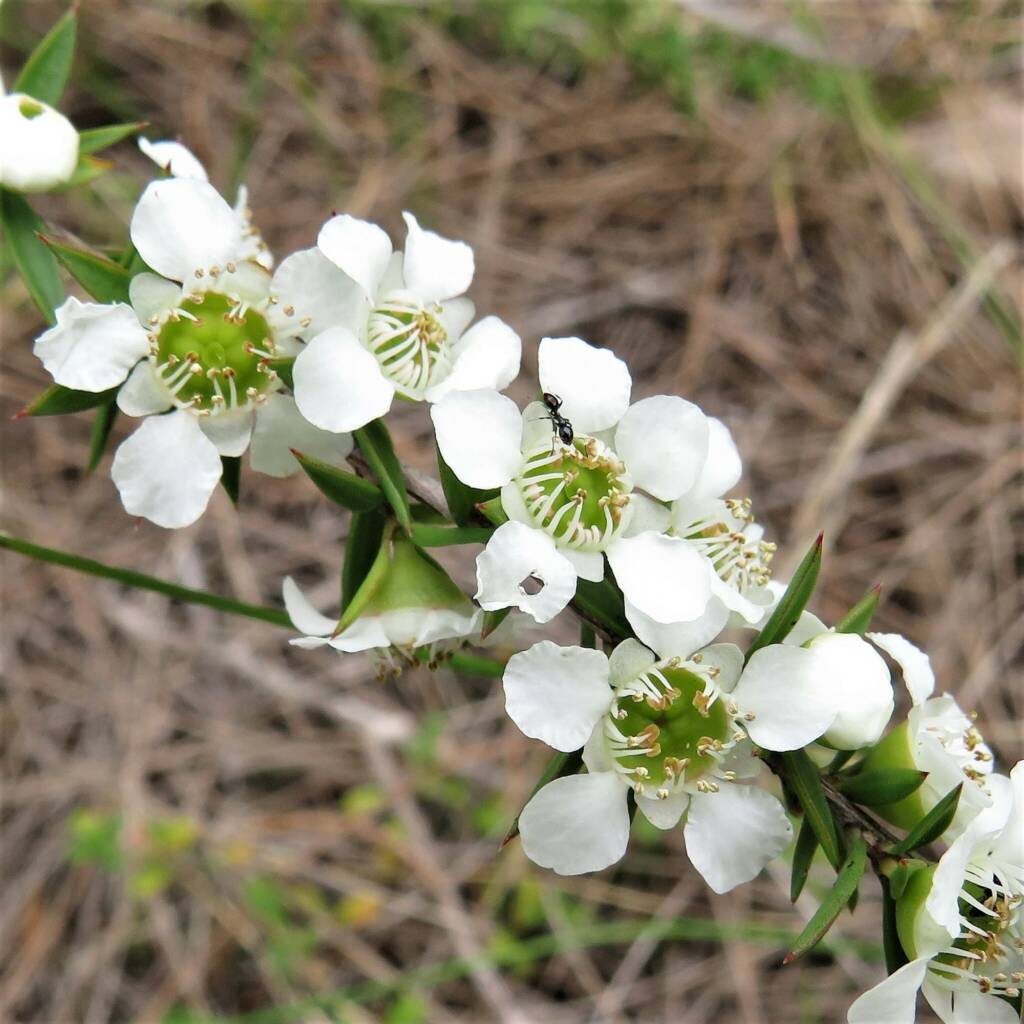LeptospermumLeptospermum continentale (Prickly Tea-Tree) Leptospermum laevigatum (Australian Tea Tree)
Leptospermum continentale is commonly known as the Prickly Tea-tree (also spelt Prickly Teatree).
Leptospermum continentale is a slender, straggling shrub that can grow to height of 1–2 m and more under the right conditions. It is endemic to the south-eastern part of Australia.
The shrub has white flowers arranged singly in leaf axils and woody fruit that remains on the plant when matures. Flowering occurs between September and February. The shrub has sharp-pointed, narrow oval-long leaves up to 13 mm long and 3.5 mm wide and has smooth bark, that sheds in stringy strips.




- Scientific classification
- Kingdom: Plantae
- Phylum: Charophyta
- Class: Equisetopsida
- Subclass: Magnoliidae
- Superorder: Rosanae
- Order: Myrtales
- Family: Myrtaceae
- Genus: Leptospermum
- Species: Leptospermum continentale
Footnote & References
- Prickly Tea-Tree (Leptospermum continentale) © Deb Taylor
- Prickly Tea-Tree (Leptospermum continentale), debtaylor142, iNaturalistAU, https://inaturalist.ala.org.au/observations/142134403
- Leptospermum continentale Joy Thomps., Prickly Teatree, Atlas of Living Australia, https://bie.ala.org.au/species/https://id.biodiversity.org.au/node/apni/2917147
LeptospermumLeptospermum continentale (Prickly Tea-Tree) Leptospermum laevigatum (Australian Tea Tree)
FloraFlora in Australia Flora Index Acacia Anigozanthos (Kangaroo Paws) Annual Yellowtop Apium prostratum subsp. prostratum var filiforme Apple Bush (Pterocaulon sphacelatum) Australian Bluebell Australian Gossypium Banksia Batswing Coral Tree Billy Buttons Birdsville Indigo Blue Pincushion Bush Banana Callistemon Callitris drummondii (Drummond’s Cypress Pine) Calothamnus quadrifidus Cape Honeysuckle Cassia fistula (Golden Shower) Cattle Bush Common Heath Crotalaria Darwinia wittwerorum (Wittwer’s Mountain Bell) Daviesia oppositifolia (Rattle-pea) Desert Oaks Drumsticks Eremophila Eucalyptus Ficus Flannel Cudweed (Actinobole uliginosum) Georges Indigo Goatshead Burr (Sclerolaena bicornis) Golden Everlasting Goodenia Gossypium Grass and Grasses Grass Trees Grevillea Grey Germander Hakea Kapok Bush (Aerva javanica) Lambertia sp Leptospermum MacDonnell Ranges Cycad Maireana scleroptera Mexican Poppy Minnie Daisy Mistletoe Family Nardoo Native Apricot Nicotiana megalosiphon subspecies sessilifolia Nuytsia floribunda Orange Spade Flower Orchidaceae Parakeelyas (Calandrinia) Pebble Bush (Stylobasium spathulatum) Perennial Yellow Top Pink Everlasting Pink Rock Wort Poached Egg Daisy Portulaca Proteaceae Ptilotus Quandong Resurrection Fern Rosy Dock Ruby Saltbush Santalum Solanum Spike Centaury Spinifex Storkbill (Erodum cygnorum) Striped Mint Bush Sturt’s Desert Pea Sturt’s Desert Rose Tall Saltbush Tangled Leschenaultia Tar Vine Tribulus eichlerianus Upside-down Plant Urodon dasyphylla Variable Daisy Waratah (Telopea) Wertabona Daisy White Cedar (Melia azedarach) White Indigo White Paper Daisy Wild Passionfruit Wild Stock Woolly-Headed Burr Daisy Woolly Bush Yellow-keeled Swainsona
Flora & FaunaFauna Flora Fauna Flora Funga Glossary Funga Related Topics Scientific Classification Backyard Wildlife Floral Emblems of Australia Wildflowers
